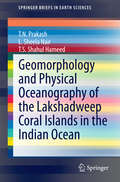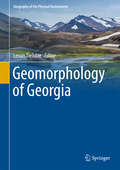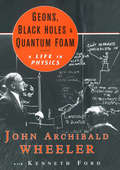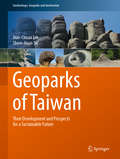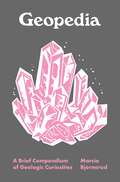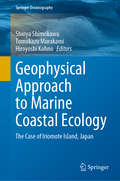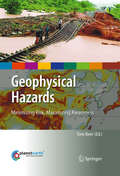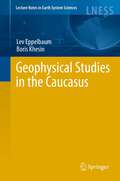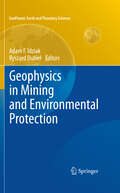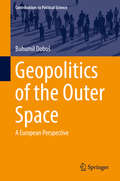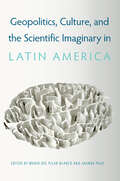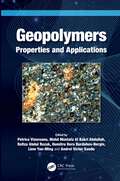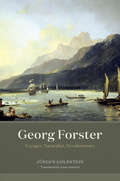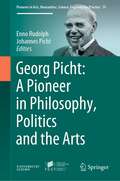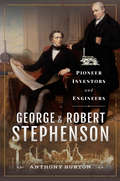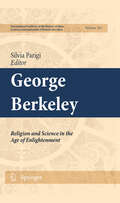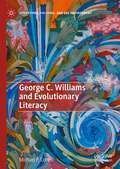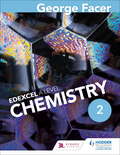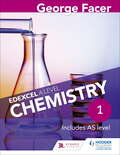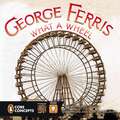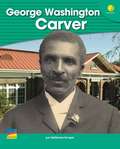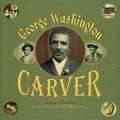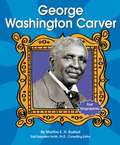- Table View
- List View
Geomorphology and Physical Oceanography of the Lakshadweep Coral Islands in the Indian Ocean
by T. N. Prakash L. Sheela Nair T.S. Shahul HameedThe Lakshadweep islands are a group of 36 coral islands in the Indian Ocean. These small islands are unique for their aquatic bio-diversity and vast blue lagoons. This book presents the results of studies done by the authors during the period 1990 to 2009 that address the beach morphology, hydrodynamics, energy resources and management options with special reference to the issue of both natural and anthropogenic coastal erosion. The relatively low island elevation makes the islands more susceptible to high-wave attack and coastal flooding during adverse weather conditions. The islands are also prone to risks from episodic events like cyclones and deep depressions. This highlights the need for a comprehensive study of the wave, climate and coastal processes at work during different seasons to delineate the factors responsible for shoreline changes and also to identify the locations that need protection and the management options. This book will serve as a guide to researchers, scholars and students who are interested in the coastal processes of coral islands.
Geomorphology of Georgia (Geography of the Physical Environment)
by Levan TielidzeThis book provides a comprehensive overview of the geomorphology of Georgia. It describes a country characterized by geological, geomorphological and geographical diversities, located in the Caucasus region at the crossroads of Europe and Asia. This book is based on the results of several years of geomorphological studies and research in Georgia, published for the first time in English, and covers a gap in research in the field of world regional geomorphology. The landscapes of Georgia consist of high glacial mountains, medium and high mountains with deeply fragmented features, narrow and deep gorges and canyons, seaside lowlands, volcanic cones, uplands and mountain ranges, intermountain plains, hollows and highlands. The peculiarity of the landscape greatly affects the natural conditions. In several chapters, this book describes the diversity of climate, hydrographic network, vegetation cover, soils, fauna, exogenic processes, natural and anthropogenic landscapes. This volume provides the readers with the opportunity to explore the variety of landscapes and landforms in this diverse and fascinating country through informative texts illustrated with many color maps and photographs. Geomorphology of Georgia appeals to scientists, scholars, teachers and any readers interested in geology, physical geography, geomorphology, tourism and environmental protection. It is a rich resource for field trips and a comprehensive guide for travelers interested in the geomorphology of Georgia.
Geons, Black Holes, and Quantum Foam: A Life in Physics
by Kenneth Ford John Archibald WheelerThe autobiography of one of the preeminent figures in twentieth-century physics. He studied with Niels Bohr, taught Richard Feynman, and boned up on relativity with his friend and colleague Albert Einstein. John Archibald Wheeler's fascinating life brings us face to face with the central characters and discoveries of modern physics. He was the first American to learn of the discovery of nuclear fission, later coined the term "black hole," led a renaissance in gravitation physics, and helped to build Princeton University into a mecca for physicists. From nuclear physics, to quantum theory, to relativity and gravitation, Wheeler's work has set the trajectory of research for half a century. His career has brought him into contact with the most brilliant minds of his field; Fermi, Bethe, Rabi, Teller, Oppenheimer, and Wigner are among those he called colleagues and friends. In this rich autobiography, Wheeler reveals in fascinating detail the excitement of each discovery, the character of each colleague, and the underlying passion for knowledge that drives him still.
Geoparks of Taiwan: Their Development and Prospects for a Sustainable Future (Geoheritage, Geoparks and Geotourism)
by Jiun-Chuan Lin Shew-Jiuan SuThis book offers an essential introduction to Taiwan’s geoparks, issues related to their development, and prospects for a sustainable future. It discusses how promoting geoparks can serve as a tool for a sustainable society based on the lessons learned in Taiwan. Situated in a tectonically dynamic geological setting (at the boundary of the Eurasian and the Philippine Plates) and culturally diversified geographical setting, Taiwan is an ideal candidate for showcasing its “natural wonders” in geoparks, promoting landscape conservation, and expanding the horizons of geoheritage world-wide. The book begins by illustrating the physical and human environments of Taiwan’s geoparks, helping readers understand their foundation. In turn, the second section includes chapters describing the development of all six Taiwanese geoparks, offering comprehensive information on each. Lastly, it illustrates the social development and mechanisms used to promote each geopark.
Geopedia: A Brief Compendium of Geologic Curiosities (Pedia Books #6)
by Marcia BjornerudA garden of geologic delights for all EarthlingsGeopedia is a trove of geologic wonders and the evocative terms that humans have devised to describe them. Featuring dozens of entries—from Acasta gneiss to Zircon—this illustrated compendium is brimming with lapidary and lexical insights that will delight rockhounds and word lovers alike.Geoscientists are magpies for words, and with good reason. The sheer profusion of minerals, landforms, and geologic events produced by our creative planet demands an immense vocabulary to match. Marcia Bjornerud shows how this lexicon reflects not only the diversity of rocks and geologic processes but also the long history of human interactions with them.With wit and warmth, she invites all readers to celebrate the geologic glossary—a gallimaufry of allusions to mythology, imports from diverse languages, embarrassing anachronisms, and recent neologisms. This captivating book includes cross-references at the end of each entry, inviting you to leave the alphabetic trail and meander through it like a river. Its pocket-friendly size makes it the perfect travel companion no matter where your own geologic forays may lead you.With whimsical illustrations by Haley Hagerman, Geopedia is a mix of engaging and entertaining facts about how the earth works, how it has coevolved with life over billions of years, and how our understanding of the planet has deepened over time.Features a real cloth cover with an elaborate foil-stamped design
Geophysical Approach to Marine Coastal Ecology: The Case of Iriomote Island, Japan (Springer Oceanography)
by Shinya Shimokawa Tomokazu Murakami Hiroyoshi KohnoThis book presents recent results of collaborative studies in geophysics and ecology, focusing on the relationship between the physical environment and the distribution of the marine coastal ecosystems. The study area, the Sakiyamawan–Amitoriwan nature conservation area in Iriomote Island of Japan, is the only oceanic nature conservation area in the country. The area has no access roads, and the bay perimeter is uninhabited; therefore, it preserves the natural environment with very little human impact. In addition, it has various environmental gradients such as topography and inflows from rivers with mangrove forests which affect the distribution of marine coastal ecosystems such as those containing reef-building corals, sea grasses, and hermit crabs. For these reasons, the area is one of the best places for the study of the relationship between the physical environment and the distribution of the marine coastal ecosystems, a relationship that is important for their conservation but has not been investigated fully. This book is aimed at students and researchers in the fields of oceanography and marine coastal ecology as well as general readers who are interested in coral reefs, diving, and nature conservation.
Geophysical Hazards
by Tom BeerThis volume, written by the Hazards Science Team of the International Year of Planet Earth, brings together some of the most influential international scientists dealing with Natural Hazards and Society's response to natural hazards. It recognises that hazards, like poverty, will always be with us but that concerted and organised societal response can prevent a hazard becoming a disaster. By bringing together geoscientists, social scientists and those concerned with the administration of international science and international disaster reduction, this book details the state-of-the-science as well as the state-of-the-response in natural hazards.
Geophysical Studies in the Caucasus
by Lev Eppelbaum Boris KhesinThe subject of this book is the methodology and results of integrated geophysical investigations in the Caucasian region, mainly interpretation of magnetic and gravity anomalies with utilization of a huge petrophysical database for the evaluation of geological structure and mineral resources. Relative voluminous geophysical data are useful for the Earth Sciences researchers interested in the Caucasian region (and adjacent and similar regions) characterized by complicated geological structure, inclined magnetization (polarization), uneven topography and mountain/sea transition. Examination of geophysical fields verified by super-deep wells drilling indicates that magmatic rocks of the Lesser Caucasus are extended northward under thick sedimentary cover of the Kura Depression up to the Greater Caucasus. These rocks form hidden petroleum-bearing traps of a newly identified type. On the basis of geophysical studies (mainly inexpensive magnetic and electric methods), a new copper-polymetallic province in the Greater Caucasus has been revealed. a newly developed integrated approach and special information-statistical techniques for processing and interpretation of geophysical data facilitate detection of important geological features, e.g. hidden intersections of linear structures that control location of large commercial ore and oil-and-gas deposits, as well as focuses of dangerous geodynamic events at a depth. Numerous illustrations (including colour) elucidate different problems and solutions on various scales and in diverse geological-geophysical environments. Many aspects of this book have been presented at the teaching courses for bachelors, masters and doctors at the Tel-Aviv University (Tel Aviv, Israel) and Ben-Gurion University (Be'er-Sheva, Israel). Benefits to readers are predetermined by the combination of the authors many-years personal experience in the geophysical studies of Azerbaijan and other regions of the Caucasus with the authors' knowledge of the modern level of geophysics in the world.
Geophysics in Mining and Environmental Protection
by Adam F. Idziak Ryszard DubielThis book contains contributions to the 32nd Polish-Czech-Slovak Symposium on Mining and Environmental Geophysics held in May 2009 in Piechowice (Poland). The papers are related to various aspects of geophysical science such as induced seismicity, engineering seismology, environmental geophysics and geophysics in geology
Geopolitics of the Outer Space: A European Perspective (Contributions to Political Science)
by Bohumil DobošThis book presents a comprehensive geopolitical analysis of European space activities. By studying outer space as a physical and socio-economic space as well as a military-diplomatic area, the author helps readers understand outer space as a geopolitical environment. The book also offers insights into the behavior and strategies of different actors, with a special focus on the European space strategy and the nature of the European space program and diplomacy.
Geopolitics, Culture, and the Scientific Imaginary in Latin America
by Joanna Page María del Pilar BlancoHighlighting the relationship among science, politics, and culture in Latin American history Challenging the common view that Latin America has lagged behind Europe and North America in the global history of science, this volume reveals that the region has long been a center for scientific innovation and imagination. It highlights the important relationship among science, politics, and culture in Latin American history.Scholars from a variety of fields including literature, sociology, and geography bring to light many of the cultural exchanges that have produced and spread scientific knowledge from the early colonial period to the present day. Among many topics, these essays describe ideas on health and anatomy in a medical text from sixteenth-century Mexico, how fossil discoveries in Patagonia inspired new interpretations of the South American landscape, and how Argentinian physicist Rolando García influenced climate change research and the field of epistemology. Through its interdisciplinary approach, Geopolitics, Culture, and the Scientific Imaginary in Latin America shows that such scientific advancements fueled a series of visionary utopian projects throughout the region, as countries grappling with the legacy of colonialism sought to modernize and to build national and regional identities.
Geopolymers: Properties and Applications
by Petrica Vizureanu Mohd Mustafa Al Bakri Abdullah Rafiza Abdul Razak Dumitru Doru Burduhos-Nergis Liew Yun-Ming Andrei Victor SanduGeopolymers presents a complex and interdisciplinary study in the fields of physics, chemistry, materials science, and civil engineering on oxide materials based on mineral wastes, known as geopolymers. Considering the ideal requirements for developing eco-friendly materials for industrial applications, this book describes how to design and develop different types of geopolymers that use mineral wastes or natural aluminosilicates as raw materials. It contains advanced knowledge and information regarding geopolymer manufacturing, development, characterization, and applications in soil stabilization, civil engineering, or ceramics. This book is relevant for undergraduate and graduate students conducting fundamental and applied research in the fields of materials engineering, ceramics engineering, and water processing.
Georg Forster: Voyager, Naturalist, Revolutionary
by Jürgen Goldstein“Marvelous. . . . Wonderfully imaginative. . . . Sparkling.”—Wall Street Journal “Stunning. . . . Read this book: in equal measure it will give you hope and trouble your dreams.”—Laura Dassow Walls, author of Henry David Thoreau: A Life and Passage to Cosmos: Alexander von Humboldt’s Shaping of America Georg Forster (1754–94) was in many ways self-taught and rarely had two cents to rub together, but he became one of the most dynamic figures of the Enlightenment: a brilliant writer, naturalist, explorer, illustrator, translator—and a revolutionary. Granted the extraordinary opportunity to sail around the world as part of Captain James Cook’s fabled crew, Forster touched icebergs, walked the beaches of Tahiti, visited far-flung foreign nations, lived with purported cannibals, and crossed oceans and the equator. Forster recounted the journey in his 1777 book A Voyage Round the World, a work of travel and science that not only established Forster as one of the most accomplished stylists of the time—and led some to credit him as the inventor of the literary travel narrative—but also influenced other German trailblazers of scientific and literary writing, most notably Alexander von Humboldt. A superb essayist, Forster made lasting contributions to our scientific—and especially botanical and ornithological—knowledge of the South Seas. Having witnessed more egalitarian societies in the southern hemisphere, Forster returned after more than three years at sea to a monarchist Europe entering the era of revolution. When, following the French Revolution of 1789, French forces occupied the German city of Mainz, Forster became a leading political actor in the founding of the Republic of Mainz—the first democratic state on German soil. In an age of Kantian reason, Forster privileged experience. He claimed a deep connection between nature and reason, nature and politics, nature and revolution. His politics was radical in its understanding of revolution as a natural phenomenon, and in this often overlooked way his many facets—as voyager, naturalist, and revolutionary—were intertwined. Yet, in the constellation of the Enlightenment’s trailblazing naturalists, scientists, political thinkers, and writers, Forster’s star remains relatively dim today: the Republic of Mainz was crushed, and Forster died in exile in Paris. This book is the source of illumination that Forster’s journey so greatly deserves. Tracing the arc of this unheralded polymath’s short life, Georg Forster explores both his contributions to literature and science and the enduring relationship between nature and politics that threaded through his extraordinary four decades.
Georg Picht: A Pioneer in Philosophy, Politics and the Arts (Pioneers in Arts, Humanities, Science, Engineering, Practice #19)
by Johannes Picht Enno RudolphAimed at an international readership, this book offers a representative collection of essays by the German philosopher, Georg Picht (1913-1982), who was a specialist in Greek philosophy, practical philosophy and philosophy of religion. Picht's themes address different disciplines, such as ancient philosophy, systematic philosophy and political analysis, and often contain critical statements on significant developments from the European Enlightenment to the Cold War era. Other essays offer a distinctive interdisciplinary approach characteristic of the author. These contributions are relevant to both philosophy and science as they discuss, for instance, philosophical definitions of space and time or the relationship between history and evolution. Another part of the book includes texts on art that present Picht’s authentic definition of art and his theory of the interdependence of art and politics.• For the first time, key texts of the German philosopher and political thinker Georg Picht are presented to a global readership in English.• Like Nietzsche’s philosophy, Picht’s work is grounded in his outstanding professionalism in the different fields of classics, embracing not only textsand theories of the great thinkers from the pre-Socratic to the post-Aristotelian and Stoic philosophies but also the main currents of ancient literature.• Picht’s importance as a political author and public adviser is exceptional, and may explain why his lifelong friend Carl Friedrich von Weizsäcker – another pioneer presented in this series – called him his “teacher”.
George & Robert Stephenson: Pioneer Inventors and Engineers
by Anthony BurtonA dual biography of the father and son railroad engineers who revolutionized Victorian transportation and reshaped modern British life.Engineer and inventor George Stephenson is known as the Father of Railways. Together with his son Robert, he built the first steam locomotive to carry passengers on a public line. They also developed much of Britain’s early railway map. In George and Robert Stephenson, industrial historian Anthony Burton examines the lives of these two giants of the late Georgian and early Victorian ages.With new research, Burton offers a fresh look at the achievements of Robert Stephenson and Company Limited, the first engineering firm devoted to railway engines. Above all, he underscores the ability of both men to overcome some of the most pressing engineering problems of their time.
George Berkeley: Religion and Science in the Age of Enlightenment
by Silvia ParigiGeorge Berkeley was considered "the most engaging and useful man in Ireland in the eighteenth century". This hyperbolic statement refers both to Berkeley's life and thought; in fact, he always considered himself a pioneer called to think and do new things. He was an empiricist well versed in the sciences, an amateur of the mechanical arts, as well as a metaphysician; he was the author of many completely different discoveries, as well as a very active Christian, a zealous bishop and the apostle of the Bermuda project. The essays collected in this volume, written by some leading scholars, aim to reconstruct the complexity of Berkeley's figure, without selecting "major" works, nor searching for "coherence" at any cost. They will focus on different aspects of Berkeley's thought, showing their intersections; they will explore the important contributions he gave to various scientific disciplines, as well as to the eighteenth-century philosophical and theological debate. They will highlight the wide influence that his presently most neglected or puzzling books had at the time; they will refuse any anachronistical trial of Berkeley's thought, judged from a contemporary point of view.
George C. Williams and Evolutionary Literacy (Literatures, Cultures, and the Environment)
by Michael P. CohenIn this book, a case study of a humanistic reading of an essential evolutionary theorist, George C. Williams (May 12, 1926–September 8, 2010), the author contends that certain classic works of evolutionary theory and history are the most important nature writing of recent times. What it means to be scientifically literate—is essential for humanistic scholars, who must ground themselves with literary reading of scientific texts. As the most influential American evolutionary theorist of the second half of the twentieth century, Williams masters critique, frames questions about adaptation and natural selection, and answers in a plain, aphoristic writing style. Williams aims for parsimony—to “recognize adaptation at the level necessitated by the facts and no higher”—through a minimalist writing style. This voice articulates a powerful process that operates at very low levels by blind and selfish chance at the expense of its designed products, using purely trial and error.
George Facer's A Level Chemistry Student Book 2
by George FacerHelps higher achieving students to maximise their potential, with a focus on independent learning, assessment advice and model assessment answers in this new edition of George Facer's best-selling textbook. - Encourages independent learning with notes and clear explanations throughout the content - Strengthens understanding with worked examples of chemical equations and calculations - Stretches the students with a bank of questions at the end of each chapter - Provides assessment guidance and sample answers
George Facer's A Level Chemistry Student Book 2
by George FacerExam Board: EdexcelLevel: AS/A-levelSubject: ChemistryFirst Teaching: September 2015First Exam: June 2017Helps higher achieving students to maximise their potential, with a focus on independent learning, assessment advice and model assessment answers in this new edition of George Facer's best-selling textbook- Encourages independent learning with notes and clear explanations throughout the content - Strengthens understanding with worked examples of chemical equations and calculations - Stretches the students with a bank of questions at the end of each chapter - Provides assessment guidance and sample answers
George Facer's Edexcel A Level Chemistry Student Book 1
by George FacerHelp higher achieving students to maximise their potential, with a focus on independent learning, assessment advice and model assessment answers in this new edition of George Facer's best-selling textbook. - Encourages independent learning with notes and clear explanations throughout the content - Strengthens understanding with worked examples of chemical equations and calculations - Stretches the students with a bank of questions at the end of each chapter - Provides assessment guidance and sample answers
George Facer's Edexcel A Level Chemistry Student Book 1
by George FacerExam Board: EdexcelLevel: AS/A-levelSubject: ChemistryFirst Teaching: September 2015First Exam: June 2016Help higher achieving students to maximise their potential, with a focus on independent learning, assessment advice and model assessment answers in this new edition of George Facer's best-selling textbook.- Encourages independent learning with notes and clear explanations throughout the content- Strengthens understanding with worked examples of chemical equations and calculations- Stretches the students with a bank of questions at the end of each chapter- Provides assessment guidance and sample answers
George Ferris, What a Wheel! (Penguin Core Concepts)
by Barbara LowellHave you ever ridden a Ferris wheel? You go up, up, up and can see for miles! But when the inventor of the Ferris wheel, George Ferris, first pitched the idea, everyone thought he was crazy. A 250-foot bicycle wheel that goes around and around and carries people in train cars? Can't be done, they said. But George proved them wrong. Read about how George's hard work, courage, and imagination created one of the most famous fair rides today.George Ferris, What a Wheel covers the concepts Imagination and Problem Solving.
George Washington Carver
by Tonya BoldenA Coretta Scott King Honor Award author offers a fresh look at this pioneering American innovator Shampoo from peanuts? Wallpaper from clay? Ink from sweet potatoes? Discover Carver's imagination and inspiration in this one-of-a-kind biography. With imagination and intellect, George Washington Carver (1864-1934) developed hundreds of unexpected products from everyday plants. This book reveals what an exceptionally uncommon man Carver was: trailblazing scholar, innovative scientist, pioneering conservationist, and impassioned educator. This book follows his life from slave and orphan to his college days as the first African American to attend Iowa State College (where he later taught), and on to his life and work in the field of agriculture. Illustrated with historical artifacts and photographs, the book traces Carver's life, discoveries, and legacy.
George Washington Carver (First Biographies)
by Martha RustadSimple text and photographs introduce the life of George Washington Carver.
